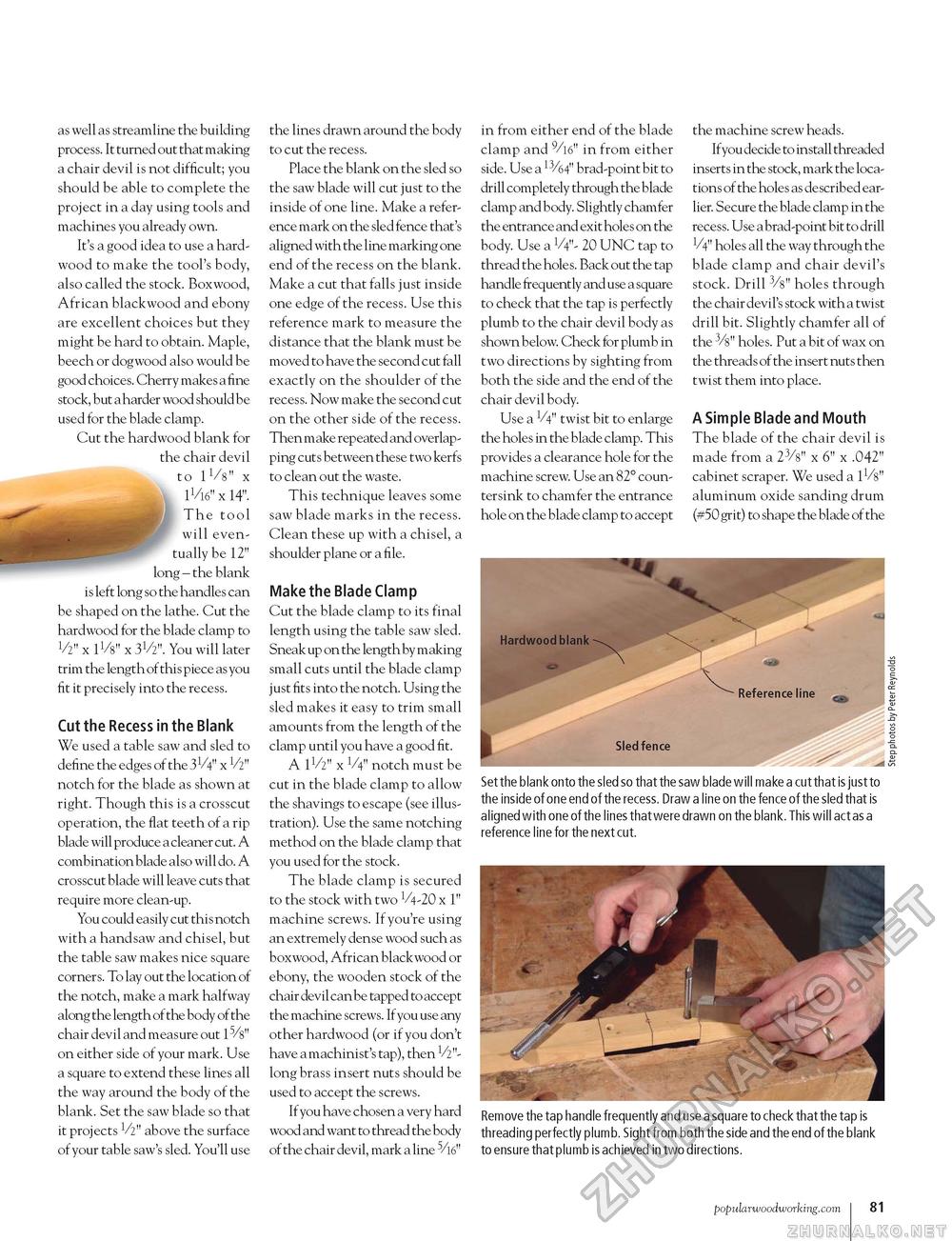Popular Woodworking 2005-12 № 152, страница 80
as well as streamline the building process. It turned out that making a chair devil is not difficult; you should be able to complete the project in a day using tools and machines you already own. It's a good idea to use a hardwood to make the tool's body, also called the stock. Boxwood, African blackwood and ebony are excellent choices but they might be hard to obtain. Maple, beech or dogwood also would be good choices. Cherry makes a fine stock, but a harder wood should be used for the blade clamp. Cut the hardwood blank for the chair devil to iVs" x 1/16" x 14". The tool will eventually be 12" long - the blank is left long so the handles can be shaped on the lathe. Cut the hardwood for the blade clamp to V2" x lVs" x 3V2". You will later trim the length of this piece as you fit it precisely into the recess. Cut the Recess in the Blank We used a table saw and sled to define the edges of the 31/4" x V2" notch for the blade as shown at right. Though this is a crosscut operation, the flat teeth of a rip blade will produce a cleaner cut. A combination blade also will do. A crosscut blade will leave cuts that require more clean-up. You could easily cut this notch with a handsaw and chisel, but the table saw makes nice square corners. To lay out the location of the notch, make a mark halfway along the length of the body of the chair devil and measure out 15/8" on either side of your mark. Use a square to extend these lines all the way around the body of the blank. Set the saw blade so that it projects V2" above the surface of your table saw's sled. You'll use the lines drawn around the body to cut the recess. Place the blank on the sled so the saw blade will cut just to the inside of one line. Make a reference mark on the sled fence that's aligned with the line marking one end of the recess on the blank. Make a cut that falls just inside one edge of the recess. Use this reference mark to measure the distance that the blank must be moved to have the second cut fall exactly on the shoulder of the recess. Now make the second cut on the other side of the recess. Then make repeated and overlapping cuts between these two kerfs to clean out the waste. This technique leaves some saw blade marks in the recess. Clean these up with a chisel, a shoulder plane or a file. Make the Blade Clamp Cut the blade clamp to its final length using the table saw sled. Sneak up on the length by making small cuts until the blade clamp just fits into the notch. Using the sled makes it easy to trim small amounts from the length of the clamp until you have a good fit. A 11/2" x 1/4" notch must be cut in the blade clamp to allow the shavings to escape (see illustration). Use the same notching method on the blade clamp that you used for the stock. The blade clamp is secured to the stock with two V4-20 x 1" machine screws. If you're using an extremely dense wood such as boxwood, African blackwood or ebony, the wooden stock of the chair devil can be tapped to accept the machine screws. If you use any other hardwood (or if you don't have a machinist's tap), then V2"-long brass insert nuts should be used to accept the screws. If you have chosen a very hard wood and want to thread the body of the chair devil, mark a line 5/16" in from either end of the blade clamp and 9/16" in from either side. Use a 13/64" brad-point bit to drill completely through the blade clamp and body. Slightly chamfer the entrance and exit holes on the body. Use a W- 20 UNC tap to thread the holes. Back out the tap handle frequently and use a square to check that the tap is perfectly plumb to the chair devil body as shown below. Check for plumb in two directions by sighting from both the side and the end of the chair devil body. Use a V4" twist bit to enlarge the holes in the blade clamp. This provides a clearance hole for the machine screw. Use an 82° countersink to chamfer the entrance hole on the blade clamp to accept the machine screw heads. Ifyou decide to install threaded inserts in the stock, mark the locations of the holes as described earlier. Secure the blade clamp in the recess. Use a brad-point bit to drill V4" holes all the way through the blade clamp and chair devil's stock. Drill 3/8" holes through the chair devil's stock with a twist drill bit. Slightly chamfer all of the 3/8" holes. Put a bit of wax on the threads of the insert nuts then twist them into place. A Simple Blade and Mouth The blade of the chair devil is made from a 23/8" x 6" x .042" cabinet scraper. We used a 11/8" aluminum oxide sanding drum (#50 grit) to shape the blade of the Set the blank onto the sled so that the saw blade will make a cut that is just to the inside of one end of the recess. Draw a line on the fence of the sled that is aligned with one of the lines that were drawn on the blank. This will act as a reference line for the next cut. Remove the tap handle frequently and use a square to check that the tap is threading perfectly plumb. Sight from both the side and the end of the blank to ensure that plumb is achieved in two directions. popularwoodworking.com 33 |








